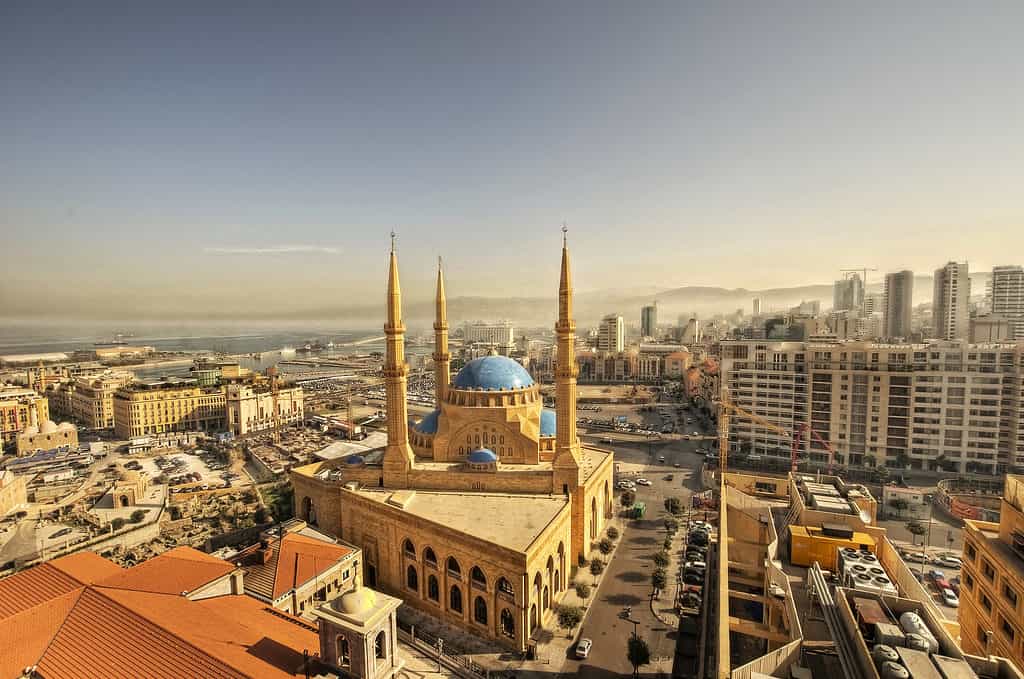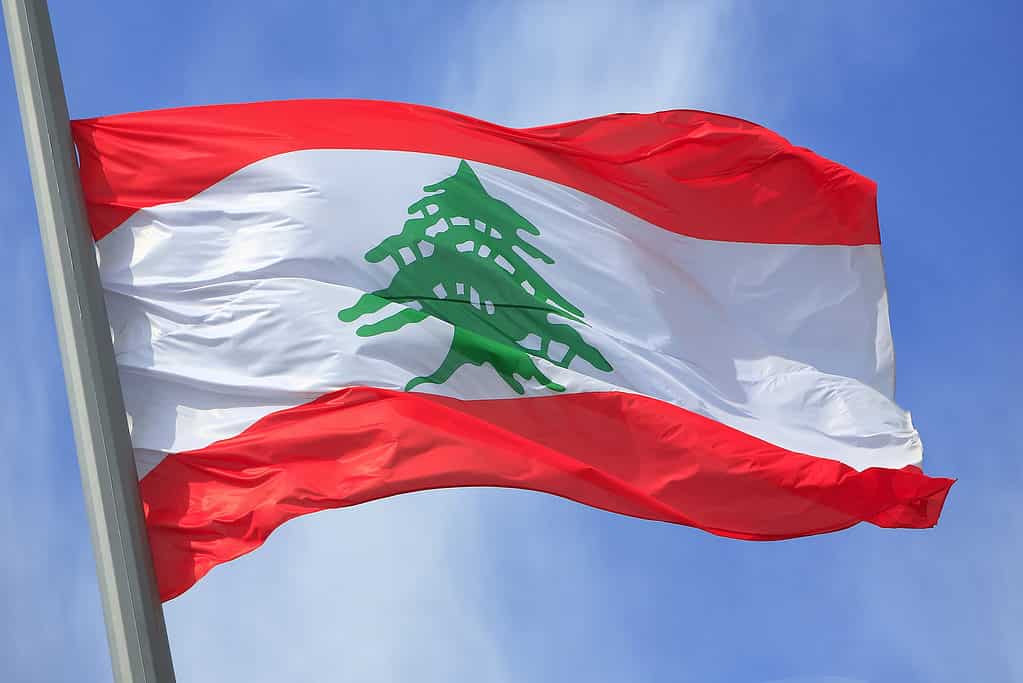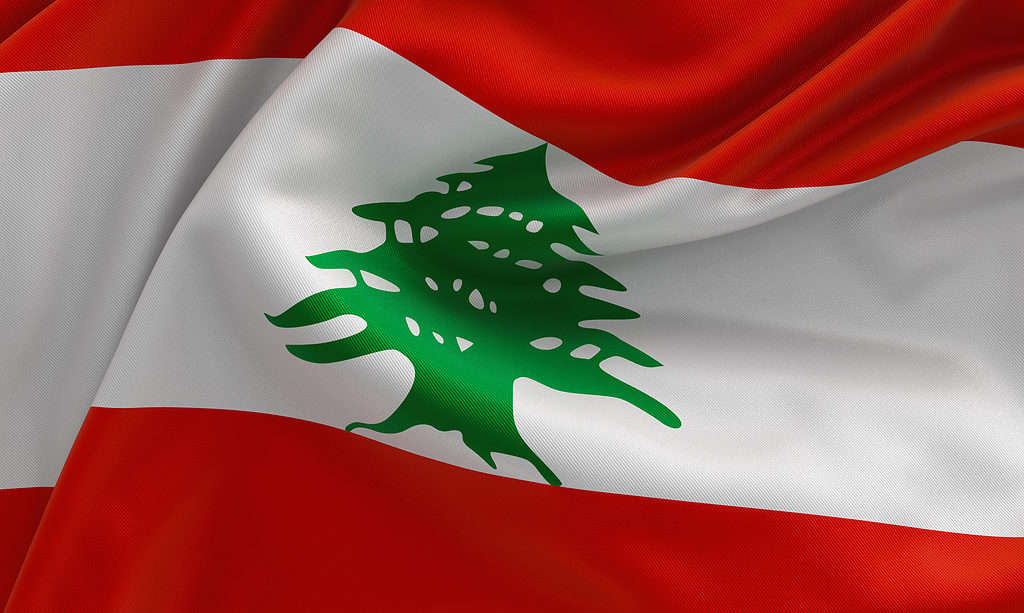The Republic of Lebanon has a population of six million, with a rich and diverse culture. The country is located in the levant region in the middle-east region of Western Asia. Lebanon has Israel to its north, Syria on its northern and eastern sides, and the Mediterranean Sea on its west. The country gained its independence in 1943. In the same year, the flag of Lebanon was designed and adopted as the country’s national emblem. Read on to discover some interesting facts about the history, meaning, and symbolism of the flag of Lebanon.

Beirut is the capital and largest city of Lebanon with a population of roughly 2.5 million.
©iStock.com/ramzihachicho
What Does the Flag of Lebanon Look Like?
Lebanon’s national flag is a rectangle like most flags (there are countries with non-rectangular flags). It is a typical Spanish fess, a horizontal tri-band flag with the central band bigger than the other two. The colored stripes come in a ratio of 1:2:1. The biggest stripe is white and is located in the center of the flag, while the remaining two equal stripes are bright red.
Many believe the Austrian flag was a source of inspiration for the Lebanese flag. However, unlike the flag of Austria, the flag of Lebanon is not plain. The iconic image of a green cedar tree is right in the middle of the flag. The tree covers about one-third of the white section of the flag. The apex and root of the tree touch the red stripes at the top and base of the flag, respectively.

The flag of Lebanon was adopted in 1943 at the time of the country’s independence.
©iStock.com/3dmitry
History of the National Flag of Lebanon
The national flag of Lebanon has been transformed many times over the years. The flag, in its current form, was adopted at the country’s independence from France in 1943. The flag was based on a design by Henri Pharaon, a member of the country’s parliament at the time. Parliament held a meeting on December 7, 1943, shortly before independence, and the flag was officially adopted during the meeting.
However, since Lebanon existed as a country even before it came under France’s control as a colony, the country has had several flag designs over the years, with the flag changing based on the person ruling the affairs of the country at the specific time.
Pre-Independence Years
Lebanon’s flag history goes back to the Phoenician Era (about 3000 BC). Between then and 200 BC, the country’s flag had a bicolor design with vertical blue and red bands. By 200 AD, the Tanakh tribe took over, and the country’s flag was changed to a five-band design with white, blue, yellow, red, and green colors. Other notable changes to the country’s flag based on who was in charge over the years include:
- Abbasid Caliphate in (750)— The flag had a plain black color
- Jerusalem (1099) — It was a white field with a large gold cross and three smaller crosses.
- Banu Ma’an Tribe (between 1119 and 1697) — A diagonal bicolor flag with white and red colors and a laurel wreath.
- The Ayyubid Dynasty (1282) — A plain yellow flag
- The Mamluk Sultanate (from the year 1250)-— Egyptian yellow field with a crescent moon
- Chehab Empire (1697)— A blue field with a crescent moon.
- The Ottoman Empire (between 1516 and 1918) — A red field with a white crescent moon and five-pointed stars. After the Ottoman Empire fell, a new flag was adopted, which included a white field with a green Lebanon cedar tree at its center.
French Colonization and Post-Independence Years
Lebanon became a French colony in 1920. The government of France approved three flags for the country. All three were tricolor flags with vertical bands and a cedar tree at the center. The bands were blue, white, and red, but the color of the cedar varied for each flag. One had a green cedar tree, the second had a black cedar, and the third had a green cedar with a brown stem.
When Lebanon gained independence in 1943, the flag with the white field, red stripes, and green cedar became the country’s official flag. The flag has retained this design since then.
The current design of the Lebanese flag is quite similar to the flag of the Ma’an Dynasty, a native Lebanese dynasty ruled by Emir Fakhr al-Din II between 1602 and 1613. The emir was one of the most notable advocates for Lebanese independence, and many believe the flag’s design is a nod to the great leader who fought against the Ottoman Empire.
Both flags had the same color scheme. The only significant difference between them is that the cedar in the modern one replaced the green wreath on the older flag. Interestingly, many government institutions within the country still use the old flag.
The Flag of Lebanon — Symbolism
Every detail present on the Lebanese national flag has a symbolic meaning tied to the country’s history and identity. The tree at the center of the flag is the Cedrus libani tree, also popularly called the Lebanese cedar or cedar of Lebanon. It is a species of tree that belongs to the pine family and has been the national symbol of Lebanon since biblical times.
The bible references the tree 77 times, and most of these references are in a positive light. The cedar of Lebanon stands for peace, steadiness, and holiness. Some also believe it represents strength and wealth. The cedar of Lebanon is abundant in the mountains of the country.
The white color represents snow, and it also signifies peace and purity. The placement of the cedar tree on a white background is a representation of what Lebanese mountains look like during certain seasons of the year, like with Cedar trees on snow-covered grounds.
Lastly, the red stripes on the flag are a representation of past bloodshed. Several Lebanese lives were lost in the attempt to keep the country from foreign invasion. The red stripes serve as a public display of respect and honor for the lost heroes.

The cedar of Lebanon at the center of the Lebanese flag stands for peace, steadiness, and holiness.
©iStock.com/Nabil Kamara
The Lebanese Military Flags
Like many other countries, the Republic of Lebanon has different flags for the various arms of its military. The former Flag of the Lebanese Armed Forces was a combination of three horizontal stripes. They were in red, white, and red like the national flag. The armed forces flag had a cedar in the middle with inscriptions written in Arabic (the country’s official language).
The present flag of the Lebanese Army has both white and red diagonals as its base. It also has the country’s coats of arms which features crossed swords, wings, and green cedar.
The country’s naval flag has an anchor and ship in its middle. The background of the flag is entirely white. The flag of the Lebanese Air Force, on the other hand, has a blue background. The iconic cedar tree and a pair of gold wings are also at the center of this flag.
Conclusion
Expectedly, Lebanese people have sentimental feelings toward their flag. It is a national symbol that holds a lot of meaning to them. The flag is a common sight at special events and is proudly displayed everywhere in government buildings and residential properties. In addition to the country’s national flag, individual municipalities such as Beirut and Sidon have their own flag as well. Click here to learn about every single flag in the world!
Up Next
- The Flag of Libya: History, Meaning, and Symbolism
- Flag of Libya: History, Meaning, and Symbolism
- The Flag of Tajikistan: History, Meaning, and Symbolism
The photo featured at the top of this post is © iStock.com/flowgraph
Sources
- Flagmakers, Available here: https://flagmakers.co.uk/buy-flags/lebanon/
- Wikipedia, Available here: https://en.wikipedia.org/wiki/Flag_of_Lebanon
- World Atlas, Available here: https://www.worldatlas.com/flags/lebanon
Thank you for reading! Have some feedback for us? Contact the AZ Animals editorial team.






